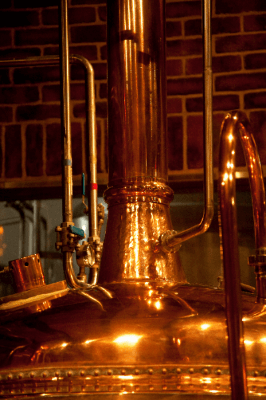What Is a Distillation Equipment?

A Distillation Equipment is used to extract a single component from a mixture of materials based on differences in boiling points.
Distillation Equipment at the laboratory level involves repeated evaporation and condensation to separate the components. In contrast, at the industrial level, a distillation equipment called a distillation column is used for continuous distillation. The distillation of alcoholic beverages employs a method known as monodistillation, where evaporation and condensation take place just once.
Applications of Distillation Equipment
Distillation Equipment is used in a variety of industrial fields. Some of these applications are listed below.
1. Petroleum Refining
Distillation Equipment is used to separate crude oil from its various components. Components with different boiling points are separated by Distillation Equipment and used as different products.
2. Alcohol Production
Distillation Equipment also plays an important role in the production of alcohol. The liquid obtained by fermentation is distilled to obtain a high concentration of alcohol.
3. Pharmaceutical Industry
Distillation Equipment is used in the pharmaceutical industry to extract active ingredients and remove impurities. This ensures the quality of the drug.
Principle of Distillation Equipment
Distillation Equipment consists of a distillation column, condenser, evaporator, and flow control valve. The liquid to be distilled is evaporated in the evaporator and sent to the distillation column. In the distillation column, continuous distillation is performed, and the separated liquid is transported back to the evaporator, while the separated gas is transported to the condenser. In the condenser, the separated gas is liquefied and separated after being cooled by cooling water or other means.
There are two types of distillation column structures: shelf columns and packed columns. In a shelf column, the interior is divided by shelves called trays, and gas and liquid are brought into contact with each other at each level, where separation takes place. In a packed column, the interior is filled irregularly on the upper side and regularly on the lower side. The packed material increases the surface area of the liquid, which allows the gas and liquid to come into contact more easily, thus increasing the efficiency of distillation. In addition, the pressure drop is less than in the shelf-stage type.
How to Select Distillation Equipment
When selecting Distillation Equipment, the following factors should be considered: strength to adequately handle the boiling and melting points of the distillate, durability of the distillate, size, and distillation speed.
Distillation Equipment at the laboratory level consists of a flask, a burner, and a cooling tube. However, at the industrial level, the scale is much larger. Because of the high throughput and the need to purify the product to the desired purity, continuous distillation is performed in a distillation column that looks like a series of stacked flasks.
In Distillation Equipment, in order to obtain the target product, the key components among the low and high boiling point components of the distillation column are determined and the distillation column is designed so that the boiling point of those components is the control temperature. Depending on the composition of the fluid to be processed in Distillation Equipment, it may be necessary to select a material that is resistant to corrosion, etc. If the quality of the material is reduced due to cost, measures must be taken, such as injecting anti-corrosion chemicals.
Other Information on Distillation Equipment
1. How to Use Distillation Equipment
Distillation Equipment is assembled with glassware at the laboratory level. The apparatus consists of a flask for the raw material, a cooling tube to cool the vapor, a thermometer, a heater (burner), a thermal insulator, and a beaker to accept the low boiling point component. A stirrer is also installed if stirring and mixing is required.
For distillation operations, set the temperature of the heater to warm the material in the flask. If a burner is used, then the adjustment is made by putting out a flame and checking the thermometer.
Water is introduced into the cooling tube by pouring it in through the inlet on the side farthest from the flask. This is because countercurrent cooling is more efficient than parallel flow for the same size of cooling pipe. In the case of laboratory-scale equipment, the temperature of the piping through which steam passes is also important because it is easily affected by the temperature of the outside air.
2. Points to Keep In Mind When Performing Distillation
In designing Distillation Equipment, the measurement position of the thermometer is important. The temperature varies depending on which part of the gas-liquid mixture in the column is being measured, so different measurement positions of the thermometer connected to the heater control will affect the separation in the distillation column itself.
The temperature of the cooling water flowing into the condenser (cooler) must also be considered. If seawater is used as cooling water, it may not be able to cool down to the target temperature during the summer. Therefore, it is ideal to use cooling water whose temperature is controlled by a cooling system.